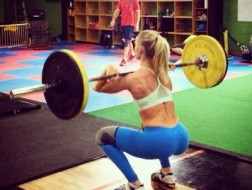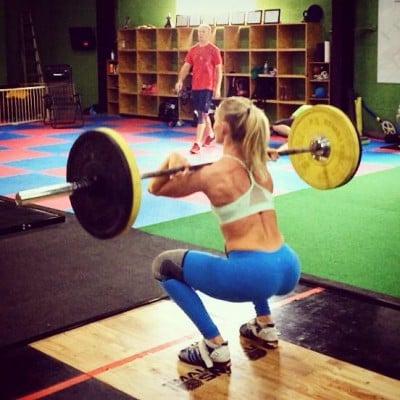Should you always wear Olympic lifting shoes when you lift or squat?

Olympic weightlifting shoes are extremely helpful. I absolutely love my old faithful Ristos. Recently though, I felt like they were starting to become a bit of a "crutch". It's not that I have any problems squatting barefoot. I actually have pretty decent squat mobility. However I started feeling uneasy lifting or squatting without my lifting shoes on, and found myself always wearing them, even for conditioning workouts and training involving light thrusters or wall balls etc., which seems a bit unneeded and not that healthy for my natural squatting patterns, knees and mobility.
I started thinking more about this and did a little research and I have since decided to mix things up a little so as not to become too dependent on these, and other lifting accessories like belts, knee sleeves etc.
There is a fine line when it comes to lifting accessories. While these tools can be extremely useful, especially when going for heavy lifts, testing, competitions etc, at the same time I've noticed the human body is extremely good at compensating for movement restrictions. Weightlifting shoes allow you to compensate somewhat for a lack of mobility…but that doesn't necessary make it always a good thing, as you are hiding from the real issue at hand (whether it's ankle or hip mobility problems, core stability and control problems etc).
"As Gray Cook has taught us, if you continue to pile fitness (strength) on top of dysfunction, bad things happen." –Eric Cressey
Now there is definitely value and benefit in wearing weightlifting shoes. They give you more stability in your squats and lifts. The other benefit of weightlifting shoes is that the extra heel height really comes in handy in such a deep squat. It can help you get low and stay upright. (Although having a more upright squat can make your squat a lot more quad-dominant, so make sure you are doing enough other glute and posterior work as well to balance everything out). And just like a weight belt, I've found it makes a pretty big difference in helping to stabilise your body during heavy lifts.
But this is also where I have a bit of an issue with weightlifting shoes, especially with beginner exercisers getting into all these accessories right away. It takes time for your body and your core to become stable under heavy loads, and I feel when we use accessories with all of our lifting, we are cheating our body out of the stabilising gains it could be making, especially in those first few years of lifting, or as a newer exerciser.
There is so much more to becoming strong than just increasing the poundage on the bar. If you have ever tried doing unilateral lifts with dumbbells or kettlebells and you find these a lot more difficult than using a bar you will understand what I mean. The challenge and demands of your core and your stability becomes so much more obvious when you lift an unstable load. It's similar to lifting without using any accessories. Your body will become stronger and you will progress in a different way, as it will need to learn to stabilise on its own and recruit your core and stabiliser muscles more for everything.
I find core strength and stability (true core strength, NOT situps) is often missing with many CrossFitters as we tend to enjoy maxing out, lifting for time and focusing on all the big lifts. We aren't afraid to lift heavy and get stronger. And while this is awesome and I love this about CrossFitters I think we would all benefit so much from not neglecting the little things: i.e. our stability work, training the smaller stabiliser muscles, breathing patterns, proper progressions with movements and squats, and not overly relying on lifting accessories just to add that extra kilo on our squat.
And this is just as much a lesson for me, as I love chasing the big weights too and often need to remind myself to slow down sometimes and do the more "boring" stuff too: the prehab work and mobility work. I have been lucky enough to not have any injuries and I think a big part of remaining injury free will come down to being faithful with these little things, even something as simple as maintaining my natural (barefoot) squat pattern, rather than relying so heavily on my weightlifting shoes.
Here’s a portion from this article on this topic by Eric Cressey. It’s a great article. I’d recommend you read the whole thing as well if you can.
By Eric Cressey:
"At some point, you've got to lose the training wheels and learn to ride the bike. And, at some point you need to stop covering up your poor movement patterns and work to address them - rather than just loading them - if you want to stay healthy....To me, squatting with a pronounced heel lift is really no different than squatting through a "butt-wink;" they are both compensations to allow a lifter to maintain the position of the center of mass within the base of support in the face of a gross extension pattern. Both fundamentally alter the ideal squat pattern, though.
In folks who have really poor squat patterns, I'd much rather see them work to improve the squat pattern for a bit, as opposed to considerable loading of the classic back squat. Once their squat pattern has improved, progressing to a front squat is a great first step, with the back squat coming a bit later on.
With all that said, before I get any hate emails, let me be abundantly clear: if you move well (i.e., have a good squat pattern to below parallel in bare feet), then by all means, feel free to use Olympic lifting shoes for your squatting and Olympic lifting, if it tickles your fancy. After all, it's only 5-10% of your training volume, most likely. Just make sure to a) only wear them for these exercises, b) maintain the underlying "heel-less" squat pattern, and c) pick the shoes with the smaller heel lift (0.5" instead of 1.25"). You might also consider wearing more minimalist footwear for the rest of your training sessions to "cancel" the O-lifting shoes out. And, again, if you're a competitive Olympic lifter, please feel free to rock whatever you want - and crush big weights doing so.
If, however, you're an athlete in another sport who uses squatting and Olympic lifting as part of your training, I don't think it's a useful addition. And, it's certainly not an appropriate initiative if you are just someone who is looking for a way to work around your poor mobility. Ignoring a fundamental movement flaw - and certainly loading it - will always come back to bite you in the butt."
So my take on all of this, is that while weightlifting shoes are a great tool to use, ultimately, you should make sure you are stable AND flexible enough (you need to be stable in the right places and mobile in the right places) first so that the shoes aren't a crutch that end up disguising any postural or mobility issues you might have.
This goes without saying that you shouldn’t wear weightlifting shoes when doing conventional deadlifts.
To finish off this post, and on a slightly different topic, here’s a portion from Lift Big, Eat Big on wearing knee sleeves as well, which I thought was interesting:
"When do I use knee or elbow sleeves?" My thinking is that if you are asking this question, you probably don't need to get them yet. You especially don't need to get them simply because you see people better than you using them. I used to wear Rehband knee sleeves for EVERY set of squats I did. I was told a theory last year, and it goes something like this: Because the fabric bunches up behind your knee in the bottom of a squat, the extra fabric pushes your patella millimeters forward every set, possibly a contributor to future knee pain. Whether this theory holds water or not, I stopped wearing knee sleeves on everything except my walking events, and have not noticed the knee pain I used to experience. If I were new, I would not worry about knee sleeves for at least 1-2 years for squatting, and even then, I would only wear them towards the end of heavy workouts, not for the entire workout."
Join the other 10,000+ who get my best fitness, diet & mindset tips.



Comments